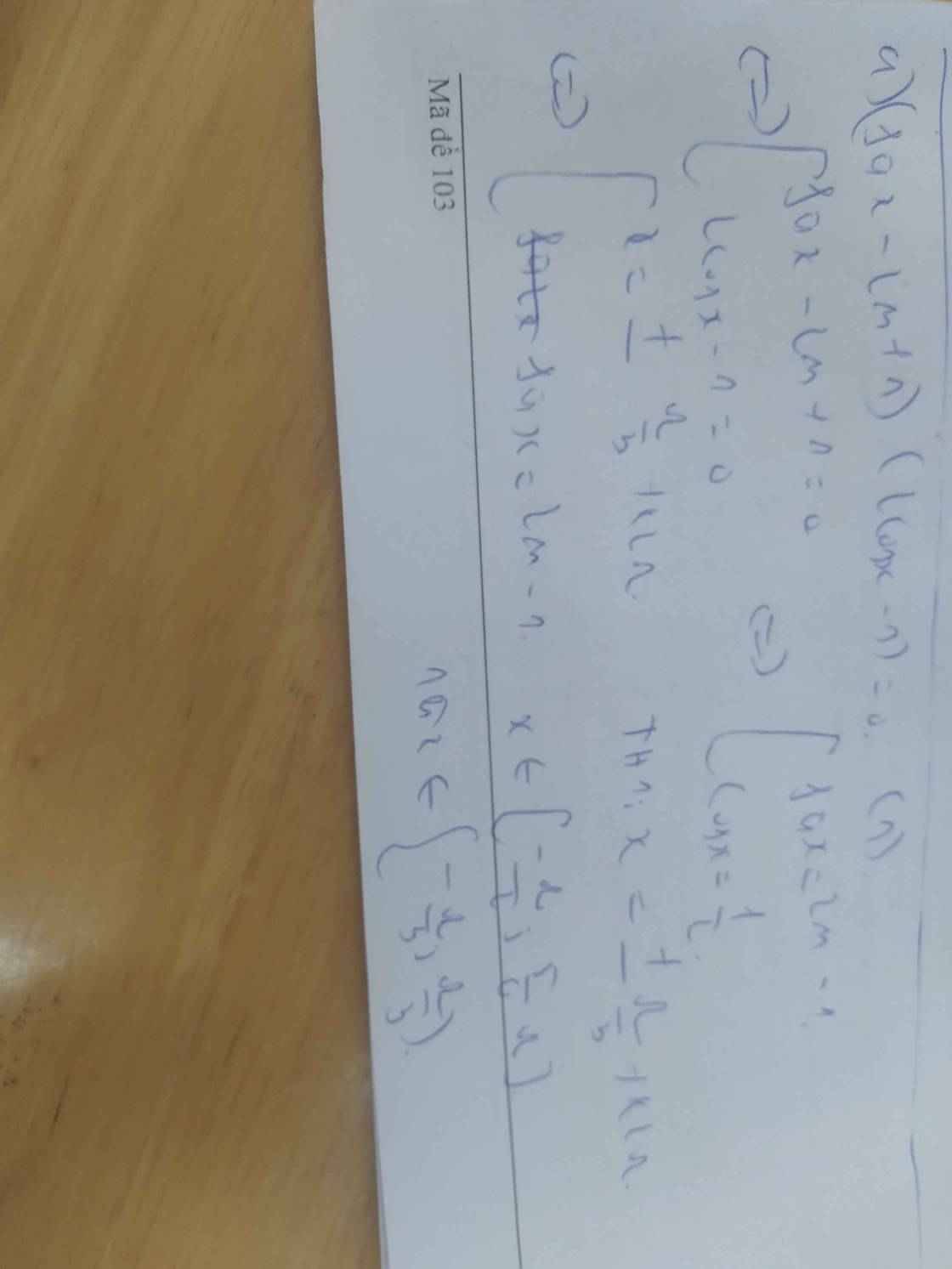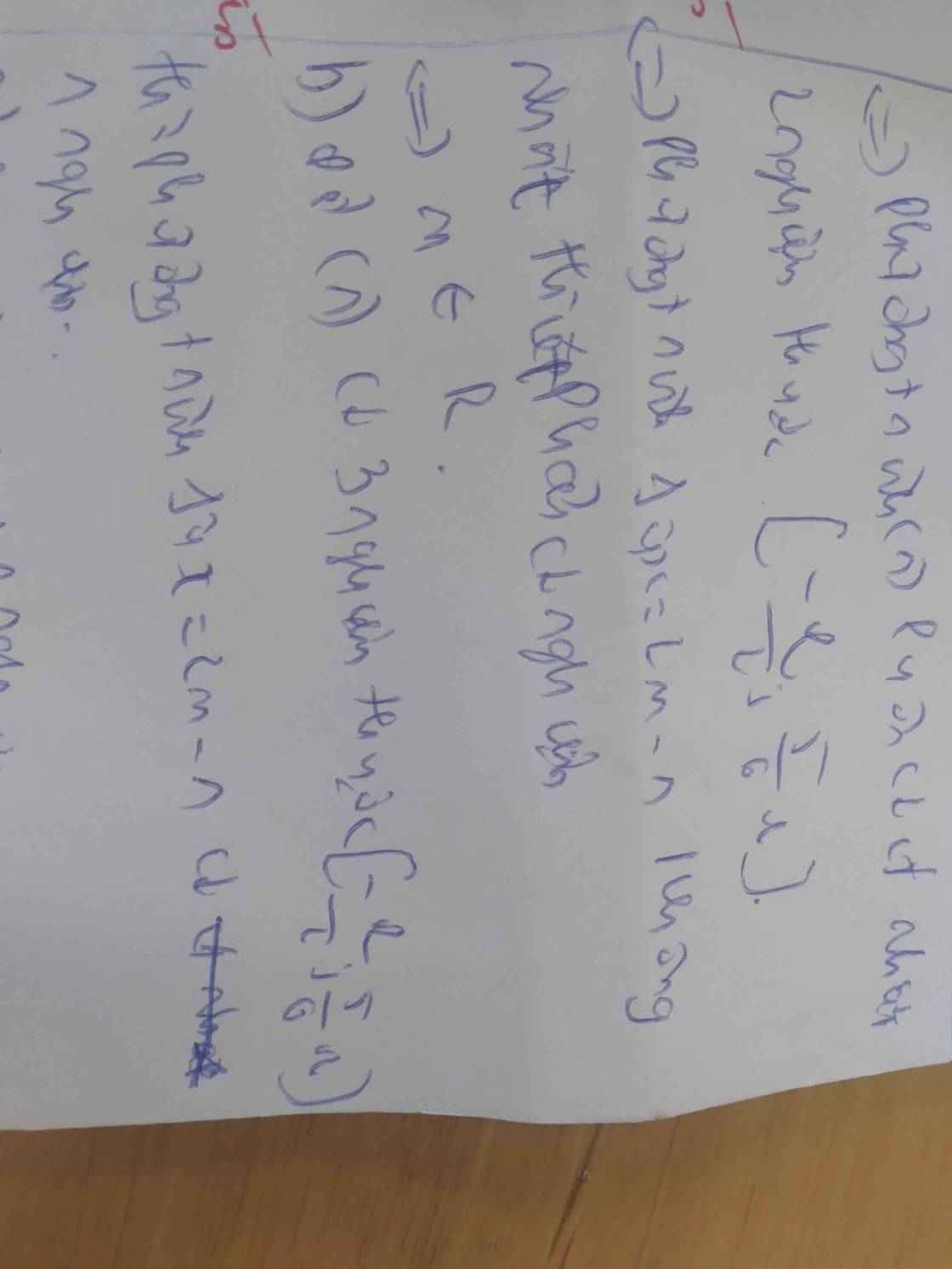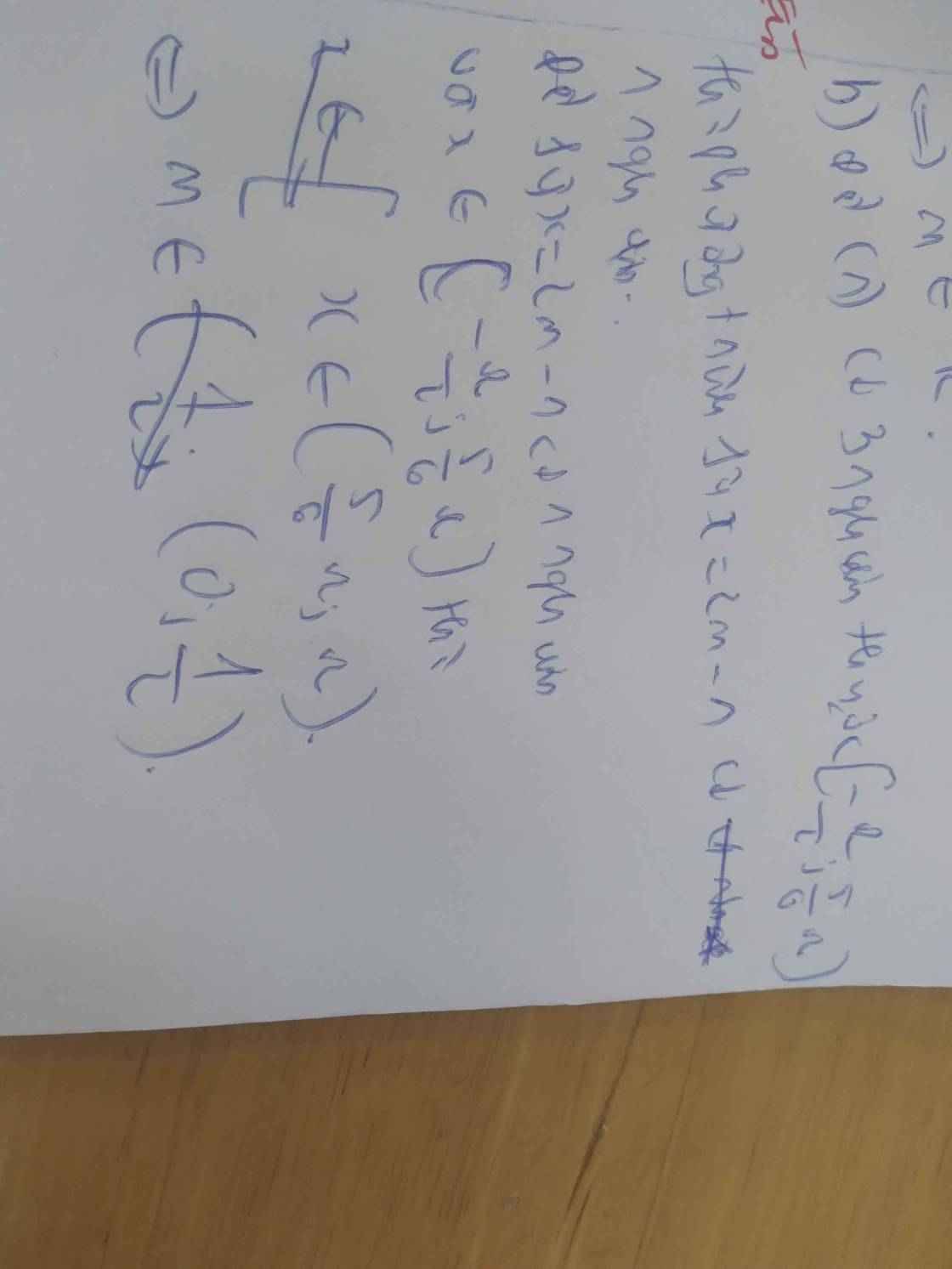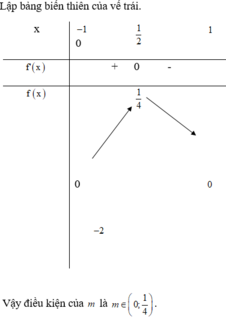Cho phương trình (1-Sinx)(Cos2x + 3mSinx+Sinx-1)=\(mCos^2x\) (m là tham số). Tìm các giá trị thực của m để phương trình có 6 nghiệm khác nhau thuộc khoảng \(\left(-\dfrac{\Pi}{2};2\Pi\right)\)

Những câu hỏi liên quan
1, cho phương trình sin2x-left(2m+sqrt{2}right)left(sinx+cosxright)+2msqrt{2}+10 tìm các giá trị m để phương trình có đúng 2 nghiệm xinleft(0;dfrac{5Pi}{4}right)2,tìm tất cả các giá trị thực của tham số m để phương trình cos2x+left(2m+1right)sinx-m-10 có đúng 2 nghiệm thuộc khoảng left(dfrac{Pi}{2};dfrac{3Pi}{2}right)3, cho phương trình cos^2x-2mcosx+6m-90 tìm các giá trị m để phương trình có nghiệm thuộc khoảng left(-dfrac{Pi}{2};dfrac{Pi}{2}right)
Đọc tiếp
1, cho phương trình \(sin2x-\left(2m+\sqrt{2}\right)\left(sinx+cosx\right)+2m\sqrt{2}+1=0\) tìm các giá trị m để phương trình có đúng 2 nghiệm \(x\in\left(0;\dfrac{5\Pi}{4}\right)\)
2,tìm tất cả các giá trị thực của tham số m để phương trình \(cos2x+\left(2m+1\right)sinx-m-1=0\) có đúng 2 nghiệm thuộc khoảng \(\left(\dfrac{\Pi}{2};\dfrac{3\Pi}{2}\right)\)
3, cho phương trình \(cos^2x-2mcosx+6m-9=0\) tìm các giá trị m để phương trình có nghiệm thuộc khoảng \(\left(-\dfrac{\Pi}{2};\dfrac{\Pi}{2}\right)\)
Tìm tất cả giá trị của tham số m để phương trình \(\left(sinx-2m+1\right)\left(2cosx-1\right)=0\)
a) Có 2 nghiệm thuộc \([-\dfrac{\pi}{2};\dfrac{5\pi}{6}]\)
b) Có 3 nghiệm thuộc \([-\dfrac{\pi}{2};\dfrac{5\pi}{6}]\)
Câu 1: Tích các nghiệm trên khoảng left(dfrac{pi}{4};dfrac{7pi}{4}right)của phương trình cos2x-3cosx+20 Câu 2: Tìm tất cả các giá trị thực của tham số m để phương trình 2cos^23x+left(3-2mright)cos3x+m-20 có đúng 3 nghiệm thuộc khoảng left(-dfrac{pi}{6};dfrac{pi}{3}right).Câu 3: Tính tổng T tất cả các nghiệm của phương trình 2sin^2dfrac{x}{4}-3cosdfrac{x}{4}0 trên đoạn left[0;8piright].Câu 4: Giá trị của m để phương trình cos2x-left(2m+1right)sinx-m-10 có nghiệm trên khoảng left(0;piright) là min...
Đọc tiếp
Câu 1: Tích các nghiệm trên khoảng \(\left(\dfrac{\pi}{4};\dfrac{7\pi}{4}\right)\)của phương trình \(cos2x-3cosx+2=0\)
Câu 2: Tìm tất cả các giá trị thực của tham số m để phương trình \(2cos^23x+\left(3-2m\right)cos3x+m-2=0\) có đúng 3 nghiệm thuộc khoảng \(\left(-\dfrac{\pi}{6};\dfrac{\pi}{3}\right)\).
Câu 3: Tính tổng T tất cả các nghiệm của phương trình \(2sin^2\dfrac{x}{4}-3cos\dfrac{x}{4}=0\) trên đoạn \(\left[0;8\pi\right]\).
Câu 4: Giá trị của m để phương trình \(cos2x-\left(2m+1\right)sinx-m-1=0\) có nghiệm trên khoảng \(\left(0;\pi\right)\) là \(m\in[a;b)\) thì a+b là?
Câu 5: Điều kiện cần và đủ để phương trình \(msinx-3cosx=5\) có nghiệm là \(m\in(-\infty;a]\cup[b;+\infty)\) với \(a,b\in Z\). Tính a+b.
Câu 6: Điều kiện để phương trình \(msinx-3cosx=5\) có nghiệm là?
Câu 7: Số nghiệm để phương trình \(sin2x+\sqrt{3}cos2x=\sqrt{3}\) trên khoảng \(\left(0;\dfrac{\pi}{2}\right)\) là?
Câu 8: Tập giá trị của hàm số \(y=\dfrac{sinx+2cosx+1}{sinx+cosx+2}\) là?
Câu 9: Có bao nhiêu giá trị nguyên của tham số m thuộc đoạn \(\left[-2018;2018\right]\) dể phương trình \(\left(m+1\right)sin^2-sin2x+cos2x=0\) có nghiệm?
Câu 10: Có bao nhiêu giá trị nguyên của tham số m để phương trình \(sin2x-cos2x+|sinx+cosx|-\sqrt{2cos^2x+m}-m=0\) có nghiệm thực?
1.
\(cos2x-3cosx+2=0\)
\(\Leftrightarrow2cos^2x-3cosx+1=0\)
\(\Leftrightarrow\left[{}\begin{matrix}cosx=1\\cosx=\dfrac{1}{2}\end{matrix}\right.\)
\(\Leftrightarrow\left[{}\begin{matrix}x=k2\pi\\x=\pm\dfrac{\pi}{3}+k2\pi\end{matrix}\right.\)
\(x=k2\pi\in\left[\dfrac{\pi}{4};\dfrac{7\pi}{4}\right]\Rightarrow\) không có nghiệm x thuộc đoạn
\(x=\pm\dfrac{\pi}{3}+k2\pi\in\left[\dfrac{\pi}{4};\dfrac{7\pi}{4}\right]\Rightarrow x_1=\dfrac{\pi}{3};x_2=\dfrac{5\pi}{3}\)
\(\Rightarrow P=x_1.x_2=\dfrac{5\pi^2}{9}\)
Đúng 1
Bình luận (0)
2.
\(pt\Leftrightarrow\left(cos3x-m+2\right)\left(2cos3x-1\right)=0\)
\(\Leftrightarrow\left[{}\begin{matrix}cos3x=\dfrac{1}{2}\left(1\right)\\cos3x=m-2\left(2\right)\end{matrix}\right.\)
\(\left(1\right)\Leftrightarrow x=\pm\dfrac{\pi}{9}+\dfrac{k2\pi}{3}\)
Ta có: \(x=\pm\dfrac{\pi}{9}+\dfrac{k2\pi}{3}\in\left(-\dfrac{\pi}{6};\dfrac{\pi}{3}\right)\Rightarrow x=\pm\dfrac{\pi}{9}\)
Yêu cầu bài toán thỏa mãn khi \(\left(2\right)\) có nghiệm duy nhất thuộc \(\left(-\dfrac{\pi}{6};\dfrac{\pi}{3}\right)\)
\(\Leftrightarrow\left[{}\begin{matrix}m-2=0\\m-2=1\\m-2=-1\end{matrix}\right.\Leftrightarrow\left[{}\begin{matrix}m=2\\m=3\\m=1\end{matrix}\right.\)
TH1: \(m=2\)
\(\left(2\right)\Leftrightarrow cos3x=0\Leftrightarrow x=\dfrac{\pi}{6}+\dfrac{k2\pi}{3}\in\left(-\dfrac{\pi}{6};\dfrac{\pi}{3}\right)\Rightarrow x=\dfrac{\pi}{6}\left(tm\right)\)
\(\Rightarrow m=2\) thỏa mãn yêu cầu bài toán
TH2: \(m=3\)
\(\left(2\right)\Leftrightarrow cos3x=0\Leftrightarrow x=\dfrac{k2\pi}{3}\in\left(-\dfrac{\pi}{6};\dfrac{\pi}{3}\right)\Rightarrow x=0\left(tm\right)\)
\(\Rightarrow m=3\) thỏa mãn yêu cầu bài toán
TH3: \(m=1\)
\(\left(2\right)\Leftrightarrow cos3x=-1\Leftrightarrow x=\dfrac{\pi}{3}+\dfrac{k2\pi}{3}\in\left(-\dfrac{\pi}{6};\dfrac{\pi}{3}\right)\Rightarrow\left[{}\begin{matrix}x=\pm\dfrac{1}{3}\\x=-1\\x=-\dfrac{5}{3}\end{matrix}\right.\)
\(\Rightarrow m=2\) không thỏa mãn yêu cầu bài toán
Vậy \(m=2;m=3\)
Đúng 2
Bình luận (0)
3.
\(2sin^2\dfrac{x}{4}-3cos\dfrac{x}{4}=0\)
\(\Leftrightarrow2cos^2\dfrac{x}{4}+3cos\dfrac{x}{4}-2=0\)
\(\Leftrightarrow\left[{}\begin{matrix}cos\dfrac{x}{4}=\dfrac{1}{2}\\cos\dfrac{x}{4}=-2\left(l\right)\end{matrix}\right.\)
\(\Leftrightarrow x=\pm\dfrac{4\pi}{3}+k8\pi\in\left[0;8\pi\right]\)
\(\Rightarrow\left[{}\begin{matrix}x=\dfrac{4\pi}{3}\\x=\dfrac{20\pi}{3}\end{matrix}\right.\)
\(\Rightarrow T=\dfrac{4\pi}{3}+\dfrac{20\pi}{3}=8\pi\)
Đúng 0
Bình luận (0)
Tìm các giá trị thực của tham số m để phương trình
(
sin
x
-
1
)
.
(
cos
2
x
-
cos
x
+
m
)
0
có đúng 5 nghiệm thuộc đoạn
0
,...
Đọc tiếp
Tìm các giá trị thực của tham số m để phương trình ( sin x - 1 ) . ( cos 2 x - cos x + m ) = 0 có đúng 5 nghiệm thuộc đoạn 0 , 2 π
A . 0 ≤ m ≤ 1 4
B . - 1 4 ≤ m ≤ 0
C . 0 ≤ m ≤ 1 4
D . - 1 4 < m < 0
số các giá trị nguyên của tham số m thuộc ( -2020;2020) để phương trình : ( m+1)cosx+(m-1)sinx =2m+3 có 2 nghiệm x1,x2 thỏa mãn \(\left|x_1-x_2\right|=\dfrac{\pi}{3}\) là
c1. điều kiện của tham số thực m để phương trình sinx +(m+1)cosxsqrt{2} vô nghiệm là c2. Hàm số ysinx đồng biến trên khoảng nào sau đây?A. left(dfrac{5pi}{4},dfrac{7pi}{4}right) B.left(dfrac{9pi}{4},dfrac{11pi}{4}right) C. left(dfrac{7pi}{4},3piright) D. left(dfrac{7pi}{4},dfrac{9pi}{4}right)Giải thích rõ chi tiết cách lm giúp tui với nha, tự học nên mù mờ quá
Đọc tiếp
c1. điều kiện của tham số thực m để phương trình sinx +(m+1)cosx=\(\sqrt{2}\) vô nghiệm là
c2. Hàm số y=sinx đồng biến trên khoảng nào sau đây?
A. \(\left(\dfrac{5\pi}{4},\dfrac{7\pi}{4}\right)\) B.\(\left(\dfrac{9\pi}{4},\dfrac{11\pi}{4}\right)\) C. \(\left(\dfrac{7\pi}{4},3\pi\right)\) D. \(\left(\dfrac{7\pi}{4},\dfrac{9\pi}{4}\right)\)
Giải thích rõ chi tiết cách lm giúp tui với nha, tự học nên mù mờ quá
C1: \(a.sinx+b.cosx=c\)
Pt vô nghiệm \(\Leftrightarrow a^2+b^2< c^2\)
Bạn áp dụng công thức trên sẽ tìm ra m
C2: (Bạn vẽ đường tròn lượng giác sẽ tìm được)
Hàm số \(y=sinx\) đồng biến trên khoảng \(\left(-\dfrac{\pi}{2}+k2\pi;\dfrac{\pi}{2}+k2\pi\right)\) ( góc phần tư thứ IV và I)
Hàm nghịch biến trên khoảng \(\left(\dfrac{\pi}{2}+k2\pi;\dfrac{3\pi}{2}+k2\pi\right)\)( góc phần tư thứ II và III)
Ý A, khoảng nằm trong góc phần tư thứ III và thứ IV => Hàm nghịch biến sau đó đồng biến
Ý B, khoảng nằm trong góc phần tư thứ I và thứ II => hàm đồng biến sau đó nghịch biến
Ý C, khoảng nằm trong góc phần tư thứ IV; I ; II => hàm đồng biền sau đó nghịch biến
Ý D, khoảng nằm trong phần tư thứ IV ; I=> hàm đồng biến
Đ/A: Ý D
(Toi nghĩ thế)
Đúng 1
Bình luận (1)
Tìm m để phương trình \(cos2x+\left(2m-3\right)sinx-m+1=0\) có đúng 7 nghiệm trên \(\left(-\dfrac{\pi}{6};3\pi\right)\)
Cho phương trình sinx(2-cos2x)-2(
2
cos
3
x
+m+1)
2
cos
3
x
+
m
+
2
3
2
cos
3
x
+
m
+
2
có bao nhiêu giá trị nguyên của tham số m để phương t...
Đọc tiếp
Cho phương trình sinx(2-cos2x)-2( 2 cos 3 x +m+1) 2 cos 3 x + m + 2 = 3 2 cos 3 x + m + 2 có bao nhiêu giá trị nguyên của tham số m để phương trình có đúng nghiệm thuộc [ 0 ; 2 π 3 ) ?
A. 1
B.2
C.3
D.4
Chọn D

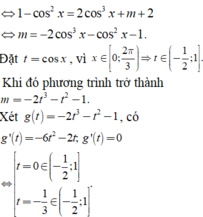
Bảng biến thiên

Dựa vào bảng biến thiên suy ra phương trình có nghiệm khi

Đúng 0
Bình luận (0)
cho phương trình \(2cos2x+sin^2xcosx+sinxcos^2x=m\left(sinx+cosx\right)\)tìm m để phương trình có ít nhất 1 nghiệm thuộc đoạn\(\left[0;\dfrac{\Pi}{2}\right]\)
\(\Leftrightarrow2\left(cos^2x-sin^2x\right)+sinx.cosx\left(sinx+cosx\right)=m\left(sinx+cosx\right)\)
\(\Leftrightarrow\left(2cosx-2sinx\right)\left(sinx+cosx\right)+sinx.cosx\left(sinx+cosx\right)=m\left(sinx+cosx\right)\)
\(\Leftrightarrow\left[{}\begin{matrix}sinx+cosx=0\left(\text{vô nghiệm trên đoạn xét}\right)\\2cosx-2sinx+sinx.cosx=m\left(1\right)\end{matrix}\right.\)
Xét (1), đặt \(t=cosx-sinx=\sqrt{2}cos\left(x+\dfrac{\pi}{4}\right)\)
\(\Rightarrow\left\{{}\begin{matrix}t\in\left[-1;1\right]\\sinx.cosx=\dfrac{1-t^2}{2}\end{matrix}\right.\)
\(\left(1\right)\Leftrightarrow2t+\dfrac{1-t^2}{2}=m\)
Xét hàm \(f\left(t\right)=-\dfrac{1}{2}t^2+2t+\dfrac{1}{2}\) trên \(\left[-1;1\right]\)
\(-\dfrac{b}{2a}=2\notin\left[-1;1\right]\) ; \(f\left(-1\right)=-2\) ; \(f\left(1\right)=2\)
\(\Rightarrow-2\le f\left(t\right)\le2\Rightarrow-2\le m\le2\)
Đúng 0
Bình luận (0)





